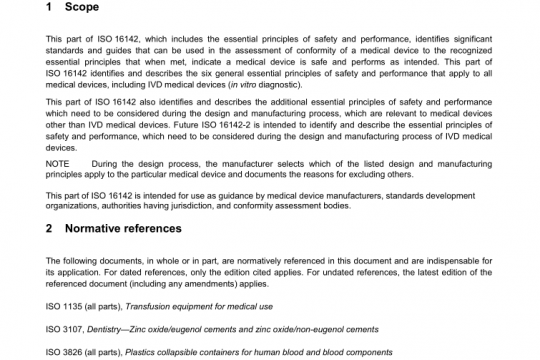AAMI CN6 pdf free download
AAMI CN6 pdf free download.Small-bore connectors for liquids and gases in healthcare applications Part 6: Connectors for neuraxial applications.
The sealing surface of female El CONNECTOR, as specified in ISO 80369-3:2015, may contact the thread surfaces of the N2 female CONNECTOR in LMC conditions when evaluating the NON-INTERCONNECTABLE characteristics tests of ISO 80369-1:2010, Annex B. Additional information is provided in G.2.
Because the following CONNECTORS are inadequately specified, SMALL-BORE CONNECTORS for use in neuraxial APPLICATIONS should not, but may connect with:
— the cones and sockets of ISO 5356-1:2004, ISO 5356-1:2015, ISO 5356-2:2006 and ISO 5356-2:2012;
the temperature sensor CONNECTOR and mating ports made in compliance with Annex DD of ISO 8185:2007; and the nipples of EN 13544-2:2002 and EN 1 3544-2:2002+A1 :2009.
The reference CONNECTORS for evaluation of the NON-INTERCONNECTABLE characteristics are described in Annex C.
The tests of Annex H shall replace ISO 80369-1:2010, Annex B.
NOTE 1 Annex H. describes a deviation to the physical test NON-INTERCONNECTABLE characteristics of ISO 80369-1:2010.
Annex B. A rationale for the deviation is provided in Annex A. For neuraxial SMALL-BORE CONNECTORS, Annex H, supersedes
ISO 80369-1:2010, Annex B.
Where the design of the SMALL-BORE CONNECTORS of this standard relies on dimensions or features of the MEDICAL DEVICE or ACCESSORY to ensure NON-INTE RCONNECTABLE characteristics, the NON-INTERCONNECTABLE characteristics shall be VERIFIED.
Check compliance by applying the tests of Annex H. Compliance also may be shown by applying a computer aided design (CAD) analysis of the dimensions of all of the ISO 80369 series SMALL BORE CONNECTORS and the SMALL BORE CONNECTOR under test, in conjunction with physical testing of the SMALL BORE CONNECTOR per Annex B where the CAD analysis does not demonstrate the NON-INTERCONNECTABLE characteristics. When necessary, the SMALL-BORE CONNECTOR may be installed on the MEDICAL DEVICE or ACCESSORY to demonstrate compliance with the NONINTERCONNECTABLE requirements of Annex H.
NOTE 2 MEDICAL DEVICES using the SMALL-BORE CONNECTORS of this standard that do not rely on the dimensions or features of
the MEDICAL DEVICE or ACCESSORY to ensure NON-INTERCONNECTABLE characteristics are presumed to comply with the NONINTERCONNECTABLE characteristics of this standard.
NOTE 3 The summary of MEDICAL DEVICES and their attributes with CONNECTIONS within this APPLICATION is provided in
informative Annex D.
NOTE 4 The summary of the usability requirements for CONNECTORS for this APPLICATION iS provided in informative Annex E. NOTE 5 The summary of criteria and requirements for CONNECTORS for this APPLICATION is provided in informative Annex F.
NOTE 6 The summary of assessment of the design of CONNECTORS for this APPLICATION according to ISO 80369-1:2010,
Clause 7, is contained in informative Annex G.
4.2 Material used for SMALL-BORE CONNECTORS
In addition to the requirements of ISO 80369-1 :2010, Clause 4, neuraxial SMALL-BORE CONNECTORS shall be made of materials with a nominal modulus of elasticity either in flexure or in tension greater than 950 MPa.
Check Compliance by application of the tests of ASTM D638-l0 or ASTM D790-10.
6.1.2 Leakage by pressure decay Neuraxial SMALL-BORE CONNECTORS evaluated for fluid leakage performance with the leakage by pressure decay TEST METHOD shall not leak by more than 0.005 Pa:m3/s while being subjected to an applied pressure of between 300 kPa and 330 kPa over a hold period between 15 s and 20 s using air as the medium. MANUFACTURERS may use a greater applied pressure or longer hold period. Check compliance by applying the tests of ISO 80369-20:2015,Annex B, while using the leakage reference CONNECTOR specified in Annex C.
6.1.3 Positive pressure liquid leakage Neuraxial SMALL-BORE CONNECTORS evaluated for fluid leakage performance with the positive pressure liquid leakage TEST METHOD shall show no signs of leakage, sufficient to form a falling drop of water, over a hold period of 30s to 35 s while being subjected to an applied pressure of between 300 kPa and 330 kPa. MANUFACTURERS may use a greater applied pressure or a longer hold period.AAMI CN6 pdf download.
Other IEC Standards
-

ANSI AAMI ISO 16142-1 pdf free download – non-IVD medical devices and guidance on the selection of standards
AAMI standards list DOWNLOAD -

ANSI AAMI ISO 16142-2 pdf free download – General essential principles and additional specifc essential principles
AAMI standards list DOWNLOAD


